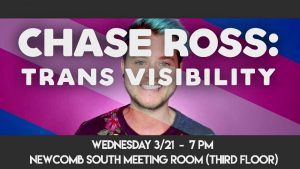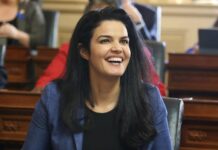
On Wednesday, students gathered in Newcomb South Meeting Room to listen to Chase Ross, a well-known YouTuber and trans rights activist, speak about his experience as a trans man and an academic.
His demeanor was light hearted, casual, and relatable. As a 27-year-old who recently completed his Masters in Sociology at Concordia University in Montreal, Canada, Ross had a very approachable, peer-like personality. His speech was as insightful as it was humorous.
He began the event with the idea of privilege. He explained, “being white, I have a privilege in society, and being male, because I do identify as male, makes me privileged… I blend into society, I look masculine, people just assume.”
A common theme Ross discussed throughout was using his platform to bring attention to trans people who do not have a voice, such as trans people of color or non-binary trans people.
“These privileges that I have had in society have helped me get to where I am today,” he said. “But I think it’s super important, as someone with privilege, to talk about the people who don’t have privilege.”
Ross discussed the increasing social awareness for the trans community. He explained how, as a confused teenager, he had no idea what a “trans person” was.
“I knew kind of what cross dressing was because South Park… [but I thought] we’re not a thing, trans people isn’t a thing. We’re just a joke on South Park…” he noted. “I never really understood that people can transition and that how you feel on the inside can be shown on the outside.”
Throughout Ross’s lifetime, he has witnessed the increase of trans characters in the likes of Shameless, The Fosters, and Orange is the New Black.
“In the last five to ten years, the visibility of the trans population has exploded… It’s just so great to see this different type of representation in the media,” he said. “And I’m thinking to myself if I was 15 and these were the types of shows on TV, I feel like it would’ve been so much easier to tell my family.”
He noted that much of this new awareness is attributed to Caitlyn Jenner’s contentious public transformation.
“I can’t talk about trans visibility without mentioning Caitlin Jenner… She has said some very problematic things in the past, especially during the election and talking about women… she is one of those people who has a lot of privilege and really doesn’t understand the amount of hate that trans people face every day,” Ross explained.
As a YouTuber since the age of fifteen, Ross also spoke about his mixed feelings toward the video platform.

“YouTube is such a big platform to feel visible and to be able to express yourself,” he said. “I didn’t have access to therapy for years, and YouTube was my therapy… YouTube has revolutionize the way that trans people are seen because I am just one trans person in front of you. I do not represent all trans people… I don’t even represent another trans person.”
However, Ross did note that YouTube’s algorithm – which classifies some videos as restricted content – continues to be problematic for trans YouTubers. This means that those videos are demonetized and age-restricted. While some of his restricted videos feature genital prosthetics, Ross explained that even videos of him baking with friends have been removed. In response to the backlash from multiple trans YouTubers, he said that “[YouTube is] trying to do better now.”
But Ross is not only a YouTube personality – he is also a published academic. It might come as a shock that his road to University actually began with him getting expelled from his high school. Shortly after, he was placed in an alternative school and seriously considered dropping out altogether.
Despite the setbacks, Ross ended up going to college and pursuing a Masters degree. His research on transgender men has been widely published, and he regularly travels to universities and other venues to give speeches about his research.
For Ross, a point of pride in all of this is his research about trans men and tattoos. “My masters research was on trans men, identity, and tattoos,” he explained.
As for Ross himself, the renowned researcher only has one tattoo, but it is a meaningful one. On his ankle he has a small squiggle line.
His reasoning? “I feel like a squiggle. I feel like I don’t belong anywhere, and that’s okay.”
















